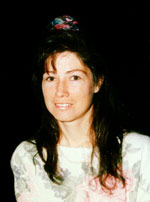 Charlene Heisler (1961 - 1999)
Charlene Heisler (1961 - 1999)

When Charlene Heisler was about to embark on her PhD in astronomy, her doctor advised that since she had cystic fibrosis and was unlikely to survive for more than a couple of years, she should abandon her idea of doing a PhD, and should instead go out and have some fun. But for Charlene, what could be more fun than the excitement of probing the cores of galaxies and uncovering the secrets of the Universe? This sense of fun propelled her right through her PhD, which she survived despite the doctors' warnings, and then through a further eight years during which she built a distinguished career as an internationally-renowned astronomer working at some of the world's top observatories.
After taking her Honours degree at Calgary, Canada, in 1985, she took her PhD at Yale, in the USA. In her 1991 PhD thesis, she studied a class of galaxies (“Peakers”) which were brightest at far-infrared wavelengths, and showed that they represented a brief phase of activity, triggered by an interaction with another galaxy. She then took up a postdoctoral position at York University, Canada, in which she continued to study Peakers and other active galaxies. In 1993 she moved to Sydney, Australia, to take up a postdoctoral position at the Anglo-Australian Observatory, and in 1996 she moved to Mount Stromlo Observatory, Canberra, where, in 1998, she was awarded a prestigious Senior Fellowship.
In 1997 she published perhaps her most significant paper, which tackled the question of why some active galaxies emit broad spectral lines visible only in polarised light. She and her colleagues showed that this “broad line” emission depends on the infrared colour and extinction of the galaxy, and that the observed properties of these galaxies depend strongly on their orientation with respect to the observer.
Her last major project was the COLA (Compact Objects in Low-power AGN) project, to see if Active Galactic Nuclei (AGN) were linked to starburst activity. One of her greatest contributions to this project was her intellectual honesty, and her habit of asking the hard question. Will it work? Do we have enough resolution? Do we have enough objects in our sample to give a statistically significant result? These vigorous discussions gradually honed the project into one that won large amounts of time on the world’s major telescopes, and attracted several distinguished international collaborators.
A 1998 visit to Chile to take observations for this project turned out to be Charlene’s last observing trip. Shortly after returning to Australia, her disease started taking the upper hand. She received a lung transplant in early 1999, which at first looked a success. Two days after the transplant she was on an exercise bike. A few days later she was taking work to her hospital bed for refereeing, and within a few weeks she was analysing data from our last spectroscopy run. But such transplants have only a 50% success rate, and the narrow path between rejection and infection is strewn with obstacles. Despite an excellent prognosis and all signs of a first-class recovery, on 28 October 1999 she suddenly deteriorated and passed away.
However, her pivotal contributions to science still live on, and her friends continue to publish papers bearing her name. But even more significant was Charlene's effect on other people. Several young people would not now be in science had it not been for Charlene's encouragement and guidance. As one student commented: "she was a wonderful friend, a big sister and an incredible inspiration".
Charlene inspired many of us to do better science, while not losing sight of our inner human selves. She showed that professional relationships don't have to be sterile, formal, caricatures, but that good science is fun, and good scientists can be warm, sincere, human beings.
Ray Norris
February 2005
